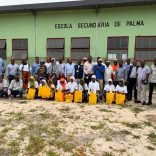Mozambique: Head of Sofala Anti-Drugs Program warns of dealers disguising themselves as students to ...
UN calls for US$10.2 million to help Mozambique

File photo
The United Nations on Wednesday renewed urgent appeals for US$10.2 million to help victims of cyclone Dineo, which hit Mozambique on February 15.
The original appeal was launched on March 1 and ran until June but only received 24 percent of the funding needed.
According to the UN, the cyclone caused seven deaths and destroyed about 20,000 houses. Five hundred and fifty thousand people needed support, but the funds available provided assistance to only 150,000.

The request for Mozambique is included in a humanitarian aid report released yesterday that updates the value needed to address all crises where the UN is involved.
As the number of people in need of humanitarian assistance around the world reach record levels, United Nations and relief partners have revised their global aid appeal to $23.5 billion – up nearly 6 per cent from the original $22.2 billion announced late last year.
According to a news release issued by the UN Office for Coordination for Humanitarian Affairs (OCHA), new natural and man-made disasters as well as deteriorating protracted emergencies have resulted in an additional 8 million people around the world needing assistance.
Since its launch on 5 December 2017, donors have provided about $6.2 billion for the 2017 global appeal. However, with more than half of the year still remaining and needs rising, more is needed.
“With generous donor support, humanitarian partners have swiftly scaled up to deliver record levels of life-saving assistance in challenging and often dangerous environments,” Stephen O’Brien, the UN Emergency Relief Coordination and head of OCHA, said on the first day of the annual Economic and Social Council Humanitarian Affairs Segment in Geneva.
“[But] we are in a race against time. People’s lives and well-being depend on increasing our collective support,” he added.
Some of the crises that pushed up the requirements include the rapid escalation of violence in Kasai province in the Democratic Republic of Congo as well as a drought in Kenya, tropical cyclones in Madagascar and Mozambique, and flooding in Peru, as well as looming famines across north-eastern Nigeria, Somalia, South Sudan and Yemen.
“With the generous support of our donors, our partners have quickly responded to deliver record levels of assistance in often challenging and dangerous environments. Donors have invested in these efforts, but we are in a war against time. -acting depends on our collective support,” said Deputy Secretary-General for Humanitarian Affairs and Emergency Aid, Stephen O’Brien.
In the first months of the year, aid reached some of the world’s most troubled areas, such as Yemen, where 5.8 million people received food and emergency aid, and South Sudan, where the aid reached more than three million people.
Assistance also reached 2.7 million Somalis and 2.2 million Syrians.













Leave a Reply
Be the First to Comment!
You must be logged in to post a comment.
You must be logged in to post a comment.